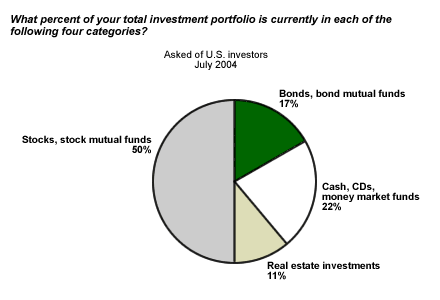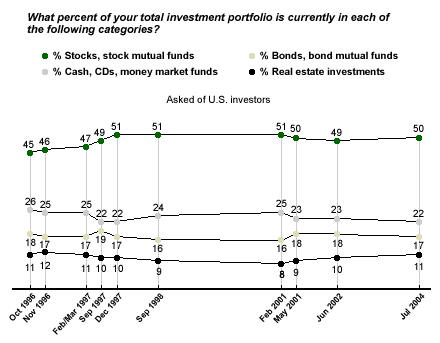Financial planners like to quote the Brinson study to emphasize to clients how important asset allocation can be. The revered 1991 study by Brinson, Singer, and Beebower shows that asset allocation accounts for more than 91% of a portfolio's performance. The study also demonstrates that the effects of stock picking and market timing on overall returns are far smaller, with individual investment selection accounting for about 5% of returns and market timing explaining about 4%.
How do U.S. investors position their portfolios? Results from the July 2004 UBS/Gallup Index of Investor Optimism survey* show that the American investor has a moderate to conservative asset allocation, with about 50% of the typical investment portfolio in stocks, 17% in bonds or bond mutual funds, 22% in cash or CDs, and the remainder in real estate (apart from the house one lives in).

Investors have generally not changed their asset allocations much since Gallup first asked this question in 1996. Equities made up 45% of the average investment portfolio in 1996, 51% in the 1990's boom, and are now holding at 50%. Cash and fixed-income positions have each fluctuated marginally around the 20% level, and real estate has accounted for approximately a tenth of all investment portfolios over this period.

Female Investors Play It Safe
The specifics of asset allocation are unique to every investor, based on one's age, goals, appetite for risk, liquidity needs, and investment horizon. But it's only natural that within the larger universe of American investors, some consistent demographic differences in investing styles will emerge.
Confirming the popular notion that female investors are more risk-averse than their male counterparts, men, on average, have 54% of their assets allocated in stocks, while women have only 42%. Female investors in turn have portfolios that are heavier in more conservative assets such as CDs or cash.
The survey differentiates between investors based on the size of their portfolios -- defining those with between $10,000 and $100,000 in investable assets as "average" investors, those with more than $100,000 in investable assets as "substantial" investors. Less affluent average investors have slightly more money in risk-free assets such as cash or CDs than do substantial investors -- 24% compared with 19%, on average.

Bottom Line
The results of the July survey reinforce that neither the Internet bubble of the 1990s nor the recent recession has diminished investors' appetite for stocks. In fact, investors across the board have been gradually increasing the equity positions in their portfolios. Mutual fund scandals, accounting fraud, and capricious business cycles notwithstanding, the American investor is still betting on the promise of wealth creation by investing in stocks.
Academic studies have documented that historically, stocks have outperformed every other asset class. Jeremy Siegel of the Wharton School has shown that stocks outperformed bonds by seven percentage points from 1926 to 1997. So while some might criticize investors for having short memories, Siegel might say that the American investor is taking a long-term view.
*Results for the Index of Investor Optimism -- U.S. are based on telephone interviews with a randomly selected U.S. sample of 802 adult investors, aged 18 and older, with at least $10,000 of investable assets, conducted July 1-18, 2004. For results based on this sample, one can say with 95% confidence that the maximum error attributable to sampling and other random effects is ±4 percentage points. In addition to sampling error, question wording and practical difficulties in conducting surveys can introduce error or bias into the findings of public opinion polls.
